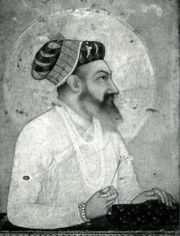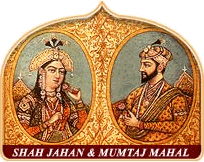Shah Jahan: Difference between revisions
No edit summary |
Allenwalla (talk | contribs) m (removed western titles of Mr. and Mrs.) |
||
| Line 1: | Line 1: | ||
[[Image:Shshjahan.JPG|thumb|right|300px| | [[Image:Shshjahan.JPG|thumb|right|300px|Emperor Shah Jahan]] | ||
Between 1636 and 1646, Shah Jahan sent Mughal armies to conquer the Deccan and the northwest beyond the Khyber Pass. Even though they aptly demonstrated Mughal military strength, these campaigns drained the imperial treasury. As the state became a huge military machine and the nobles and their contingents multiplied almost fourfold, so did the demands for more revenue from the peasantry. Political unification and maintenance of law and order over wide areas encouraged the emergence of large centers of commerce and crafts--such as Lahore, Delhi, Agra, and Ahmadabad--linked by roads and waterways to distant places and ports. The world-famous Taj Mahal was built in Agra during Shah Jahan's reign as a tomb for his beloved wife, Mumtaz Mahal. It symbolizes both Mughal artistic achievement and excessive financial expenditures when resources were shrinking. | Between 1636 and 1646, Shah Jahan sent Mughal armies to conquer the Deccan and the northwest beyond the Khyber Pass. Even though they aptly demonstrated Mughal military strength, these campaigns drained the imperial treasury. As the state became a huge military machine and the nobles and their contingents multiplied almost fourfold, so did the demands for more revenue from the peasantry. Political unification and maintenance of law and order over wide areas encouraged the emergence of large centers of commerce and crafts--such as Lahore, Delhi, Agra, and Ahmadabad--linked by roads and waterways to distant places and ports. The world-famous Taj Mahal was built in Agra during Shah Jahan's reign as a tomb for his beloved wife, Mumtaz Mahal. It symbolizes both Mughal artistic achievement and excessive financial expenditures when resources were shrinking. | ||
[[Image:Shahjahan.gif|thumb|left|300px| | [[Image:Shahjahan.gif|thumb|left|300px|Shah Jahan with his wife Begum Mumtaz Mahal]] | ||
The economic position of peasants and artisans did not improve because the administration failed to produce any lasting change in the existing social structure. There was no incentive for the revenue officials, whose concerns primarily were personal or familial gain, to generate resources independent of dominant Hindu zamindars and village leaders, whose self-interest and local dominance prevented them from handing over the full amount of revenue to the imperial treasury. In their ever-greater dependence on land revenue, the Mughals unwittingly nurtured forces that eventually led to the break-up of their empire. | The economic position of peasants and artisans did not improve because the administration failed to produce any lasting change in the existing social structure. There was no incentive for the revenue officials, whose concerns primarily were personal or familial gain, to generate resources independent of dominant Hindu zamindars and village leaders, whose self-interest and local dominance prevented them from handing over the full amount of revenue to the imperial treasury. In their ever-greater dependence on land revenue, the Mughals unwittingly nurtured forces that eventually led to the break-up of their empire. | ||
Revision as of 03:14, 19 June 2010
Between 1636 and 1646, Shah Jahan sent Mughal armies to conquer the Deccan and the northwest beyond the Khyber Pass. Even though they aptly demonstrated Mughal military strength, these campaigns drained the imperial treasury. As the state became a huge military machine and the nobles and their contingents multiplied almost fourfold, so did the demands for more revenue from the peasantry. Political unification and maintenance of law and order over wide areas encouraged the emergence of large centers of commerce and crafts--such as Lahore, Delhi, Agra, and Ahmadabad--linked by roads and waterways to distant places and ports. The world-famous Taj Mahal was built in Agra during Shah Jahan's reign as a tomb for his beloved wife, Mumtaz Mahal. It symbolizes both Mughal artistic achievement and excessive financial expenditures when resources were shrinking.
The economic position of peasants and artisans did not improve because the administration failed to produce any lasting change in the existing social structure. There was no incentive for the revenue officials, whose concerns primarily were personal or familial gain, to generate resources independent of dominant Hindu zamindars and village leaders, whose self-interest and local dominance prevented them from handing over the full amount of revenue to the imperial treasury. In their ever-greater dependence on land revenue, the Mughals unwittingly nurtured forces that eventually led to the break-up of their empire.
| These articles deal with Mughal Empire |
|
Babur (1526-30) -|- Humayun (1530-56) -|- Akbar (1556-1605) -|- Jahangir (1605-27) -|- Shah Jahan (1627-58) -|- Aurangzeb (1658-1707) |


